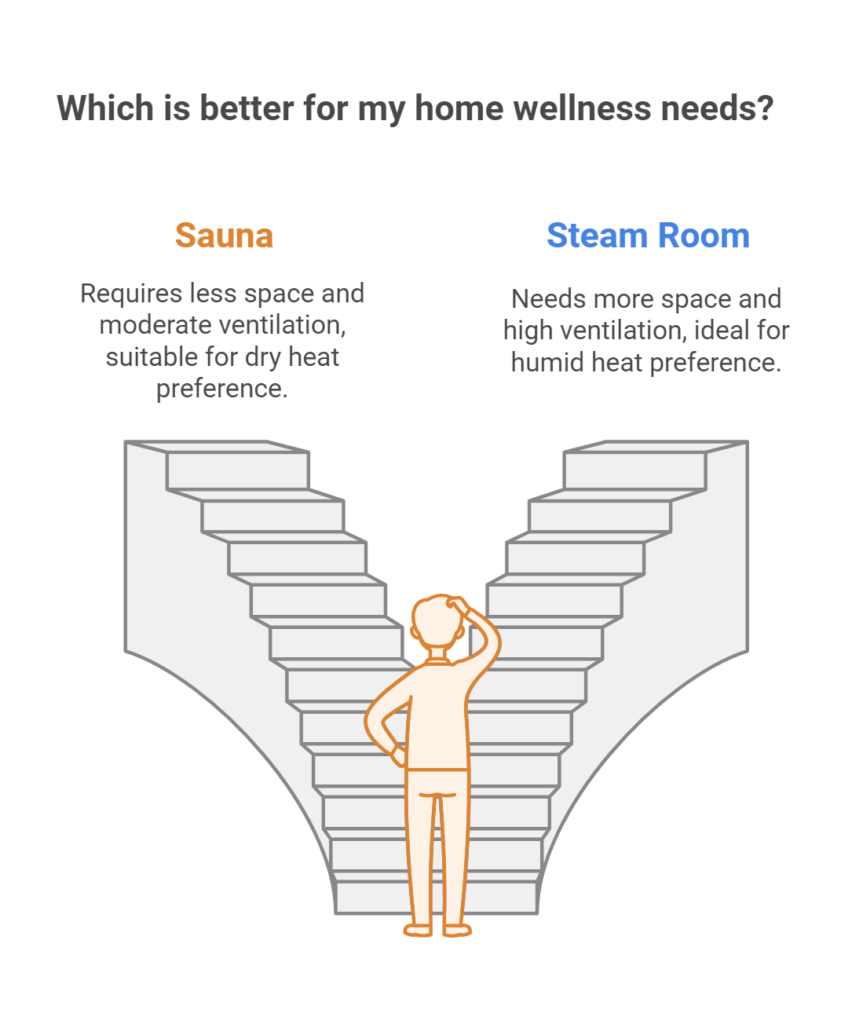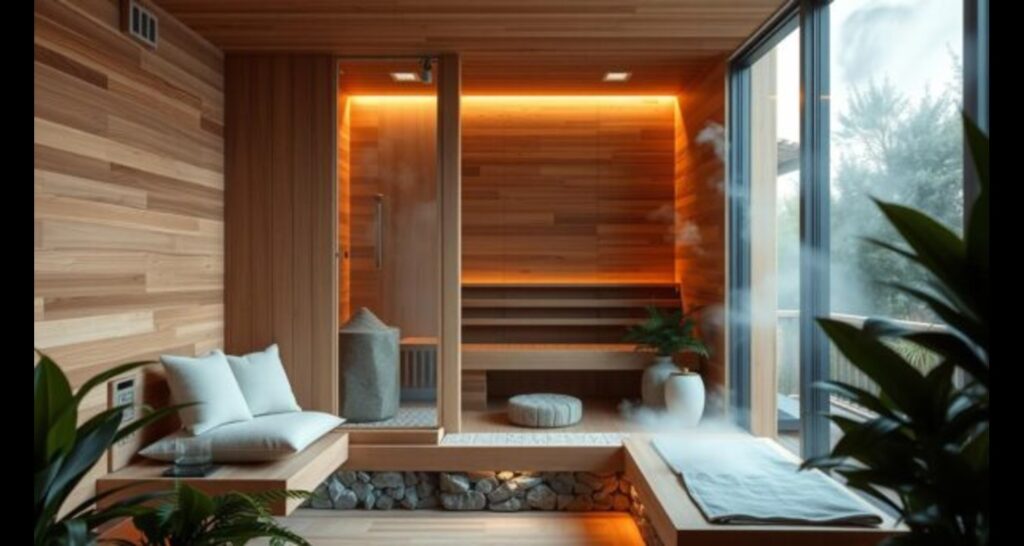Ever thought about bringing spa luxury into your home? Creating a home sauna or steam room could be the answer. With wellness and self-care on the rise, more people are setting up their own relaxation spaces. But how do you design the perfect peaceful spot at home?
A well-designed home sauna or steam room is more than a place to relax. It’s a sanctuary where stress fades, muscles unwind, and your body refreshes. It can boost circulation and improve skin health. Let’s look at how to turn a home corner into a warm, serene haven.
Table of Contents
Key Takeaways
- Home saunas and steam rooms provide spa-like relaxation at home
- Proper design enhances health benefits and stress relief
- Space assessment is crucial for successful installation
- Choose between traditional and infrared sauna options
- Material selection impacts durability and aesthetics
- Incorporate features like aromatherapy for a luxurious experience
Understanding the Benefits of Home Saunas and Steam Rooms
Home saunas and steam rooms are great for your health and happiness. You can pick a traditional sauna or a portable steam room. These places can change your daily life for the better.
Health Advantages of Regular Sauna Use
Using a sauna often can make your heart and immune system stronger. It boosts blood flow, which is good for your health. A home steam bath can also help you sleep well and recover quickly from hard workouts.
Stress Reduction and Relaxation Benefits
Saunas are a safe place to relax and reduce stress. The heat relaxes muscles and makes you feel happier. Just a few minutes in a portable steam room sauna can clear your mind.
Improved Skin Health from Steam Room Sessions
Steam rooms are great for your skin. The moist heat opens up your pores, cleanses your skin, and makes it glow. Using a home steam bath regularly can make your skin clearer and more radiant.
| Benefit | Sauna | Steam Room |
|---|---|---|
| Heat Type | Dry | Moist |
| Temperature | Higher | Lower |
| Skin Effect | Sweating | Hydration |
| Respiratory | Mild | Significant |
Saunas and steam rooms each have their own benefits. Pick the one that suits your health needs and preferences for your home wellness area.
Key Differences Between Saunas and Steam Rooms
When planning your home sauna steam room, it’s crucial to understand the distinctions between these two relaxation spaces. Saunas and steam rooms offer unique experiences, each with its own set of benefits.

Saunas typically operate at higher temperatures, ranging from 160°F to 200°F. They use dry heat, with humidity levels below 20%. This dry environment promotes intense sweating and detoxification. In contrast, a steamroom for home maintains lower temperatures, usually between 110°F and 120°F, but with nearly 100% humidity.
| Feature | Sauna | Steam Room |
|---|---|---|
| Temperature | 160°F – 200°F | 110°F – 120°F |
| Humidity | Below 20% | Near 100% |
| Heat Source | Heated rocks or infrared heaters | Steam generator |
Saunas often use heated rocks or infrared heaters to create warmth. Steam rooms rely on a generator to produce moist heat. This difference in heating methods contributes to varying health benefits. Saunas may help with muscle relaxation and cardiovascular health, while steam rooms can improve respiratory function and skin hydration.
When designing your home sauna steam room, consider your personal preferences and health goals. Some homeowners even opt for a combination unit, allowing them to enjoy the best of both worlds in one compact space.
Assessing Your Space: Where to Install Your Home Sauna or Steam Room
Choosing the right spot for your home steam bath or portable steam room sauna is key for a relaxing experience. Let’s look at the best locations and things to consider for your new wellness retreat.
Ideal Locations Within Your Home
The perfect spot for your sauna or steam room depends on your home’s layout. Basements are popular because they offer privacy and are moisture-resistant. Garages, spare rooms, or outdoor spaces can also work. The main thing is to find a spot that’s easy to get to but still private.
Space Requirements
Space needs differ based on the sauna or steam room type. A home sauna kit needs at least 4×5 feet for a single-person unit. Larger models might need up to 8×8 feet. Portable steam room saunas are more compact, fitting in spaces as small as 3×3 feet.
Ventilation and Moisture Control
Good ventilation is key for both saunas and steam rooms. Install exhaust fans to remove excess moisture and keep air quality good. For steam rooms, make sure walls and floors are waterproof to avoid damage. Think about using a vapor barrier and a proper drainage system to protect your home from humidity problems.

By carefully thinking about these factors, you’ll make a relaxing and beneficial space for your home sauna or steam room experience.
Choosing Between Traditional and Infrared Saunas
When planning your home sauna steam room, you’ll face a key decision: traditional or infrared? Each type offers unique benefits for your wellness routine. Traditional saunas use heated rocks to warm the air, while infrared saunas directly heat your body with light waves.

Traditional saunas create a classic steam experience, perfect for those who enjoy intense heat and humidity. They’re ideal for detoxification and muscle relaxation. Infrared saunas, on the other hand, operate at lower temperatures, making them more comfortable for longer sessions. They’re known for their deep tissue penetration and cardiovascular benefits.
Space is a crucial factor in your choice. Traditional saunas often require more room and complex installation. If you’re tight on space, a portable steam room sauna might be your best bet. These compact units offer flexibility and easy setup, perfect for small homes or apartments.
| Feature | Traditional Sauna | Infrared Sauna |
|---|---|---|
| Heat Source | Heated rocks | Infrared light |
| Temperature Range | 150-195°F | 120-150°F |
| Humidity Level | High | Low |
| Heat-up Time | 30-40 minutes | 10-20 minutes |
| Energy Efficiency | Lower | Higher |
Consider your wellness goals when making your choice. If you’re after a traditional steam experience, go for a classic sauna. If you prefer gentler heat and longer sessions, an infrared sauna might be your ideal home sauna steam room solution.
Essential Features for a Luxurious Home Steam Room
Creating a luxurious steamroom for home needs careful planning and detail. A well-designed home steam bath can turn your daily routine into a spa-like experience. Let’s look at the key elements that make a home steam room truly exceptional.
Steam Generators and Controls
The heart of any home steam bath is its generator. Modern steam generators offer precise temperature control and energy efficiency. Look for units with digital controls, allowing you to set your preferred temperature and duration. Some advanced models even include smartphone integration for remote operation.
| Feature | Benefit |
|---|---|
| Digital controls | Precise temperature management |
| Auto-drain function | Reduces mineral buildup |
| Aroma therapy reservoirs | Enhances relaxation experience |
Seating Options and Materials
Comfort is key in a steamroom for home. Choose seating that’s ergonomic and made from materials that can withstand high humidity. Teak and cedar are popular choices for their durability and natural resistance to moisture. Consider built-in benches or foldable seats to maximize space in smaller steam rooms.
Lighting and Ambiance Considerations
The right lighting can elevate your home steam bath experience. Opt for waterproof LED fixtures that offer adjustable brightness and color options. Soft, warm tones create a relaxing atmosphere, while chromotherapy lighting can enhance mood and well-being. Don’t forget to include a waterproof speaker system for soothing music or guided meditation sessions.
By focusing on these essential features, you can create a steamroom for home that rivals any luxury spa. Your home steam bath will become a sanctuary for relaxation and rejuvenation, right in the comfort of your own space.
Designing for Comfort: Ergonomics and Layout
Creating a cozy home sauna steam room begins with smart design. The layout should use space wisely for a relaxing experience. Start by planning enough seating for users to recline comfortably.
For a steamroom at home, think about built-in benches with smooth edges. This prevents discomfort.
Headroom is key in any home sauna steam room. Aim for at least 7 feet of ceiling height. This allows for standing and stretching. Place heaters or steam outlets to distribute heat or steam evenly.
In a home sauna, put the heater low and in the center. This ensures even heat circulation.
Ergonomics are crucial for your relaxation space. Design tiered seating for different heat preferences. Higher benches are for those who like it hotter.
For a steamroom at home, slope the ceiling slightly. This prevents water droplets from falling on people.
Think about the flow of movement in your space. Make sure there’s enough room between benches for easy access and comfort. A well-designed layout can turn your home sauna steam room into a sanctuary of relaxation, just like a professional gym.
- Install non-slip flooring for safety
- Include a small shelf for water bottles or aromatherapy oils
- Add hooks near the entrance for towels and robes
By focusing on these ergonomic details, your home sauna or steam room will become a haven of comfort and rejuvenation.
Materials and Finishes for Durability and Aesthetics
Choosing the right materials for your home steam bath or portable steam room sauna is key. It affects both how long it lasts and how it looks. Let’s look at the best options for a luxurious and durable space.
Best Woods for Sauna Construction
Wood selection is crucial when building a sauna. Cedar and hemlock are top picks because they resist moisture and smell nice. These woods can handle high temperatures without warping or releasing harmful chemicals.
Moisture-Resistant Options for Steam Rooms
Steam rooms need materials that can handle constant moisture. Ceramic tiles, glass, and non-porous stones like marble are great choices. These materials resist water damage and add a luxurious feel to your home steam bath.
Flooring Choices for Safety and Style
Safety is key when picking flooring for your sauna or steam room. Textured tiles or wood slats offer grip and prevent slips. For a portable steam room sauna, removable wooden floor mats are both practical and stylish.
| Material | Sauna Use | Steam Room Use | Durability | Aesthetics |
|---|---|---|---|---|
| Cedar | Excellent | Good | High | Natural Beauty |
| Ceramic Tiles | Fair | Excellent | Very High | Versatile Designs |
| Marble | Poor | Excellent | High | Luxurious |
| Textured Tiles | Good | Excellent | High | Modern Look |
Incorporating Aromatherapy and Chromotherapy
Make your home sauna steam room even better with aromatherapy and chromotherapy. These add-ons can turn your space into a wellness paradise. Essential oils in your sauna help you relax and reduce stress.
Try lavender for calmness, eucalyptus for breathing, or peppermint for energy in your sauna. Chromotherapy uses colors to affect your mood and health. Blue light can calm you, while red boosts energy.
Put these together in your steamroom for a unique retreat. Add color-changing LED lights and an essential oil diffuser. This mix of aromatherapy and chromotherapy turns your sauna into a luxury spa. It makes your wellness routine even better.








13 thoughts on “Home Saunas and Steam Rooms: How to Design a Home Sauna and Steam Room for Ultimate Relaxation?”